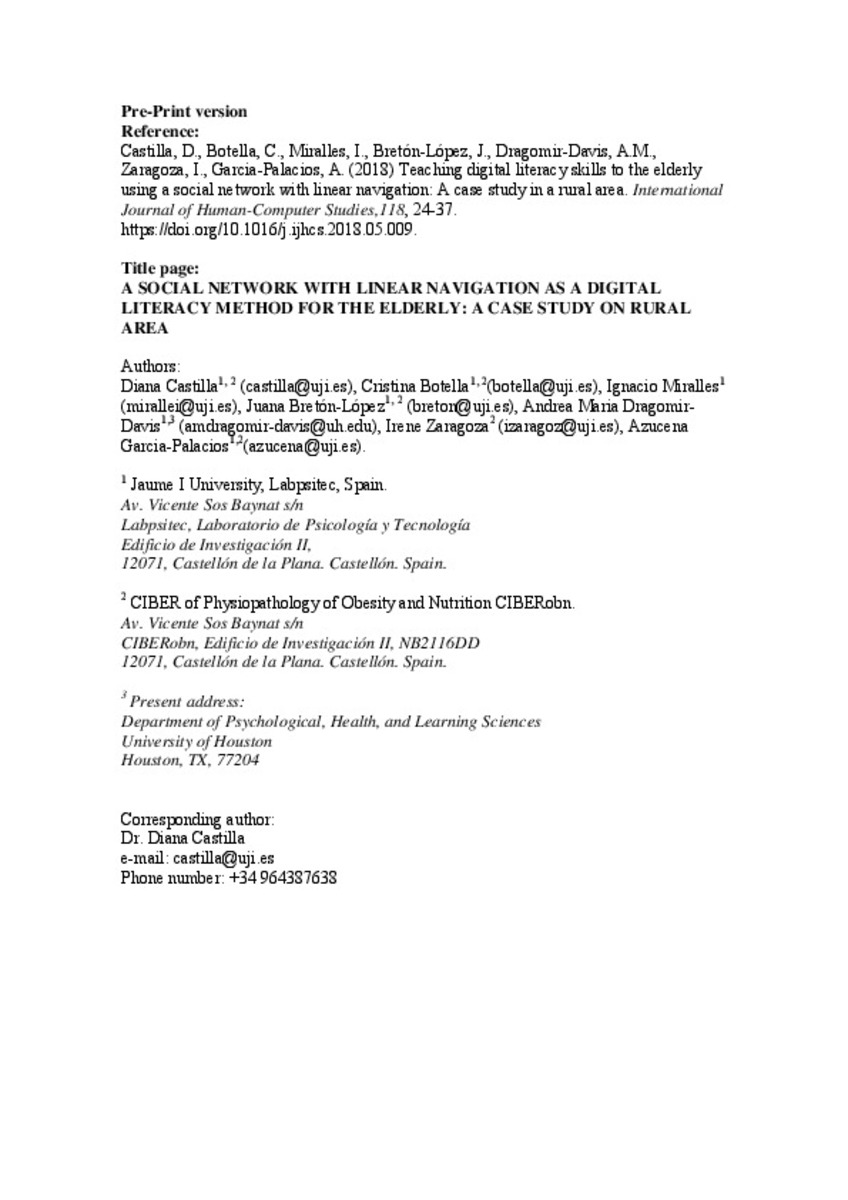Mostrar el registro sencillo del ítem
Teaching digital literacy skills to the elderly using a social network with linear navigation: A case study in a rural area
| dc.contributor.author | Castilla, Diana | |
| dc.contributor.author | Botella, Cristina | |
| dc.contributor.author | Miralles, Ignacio | |
| dc.contributor.author | Bretón-López, Juana | |
| dc.contributor.author | Dragomir-Davis, Andreea Maria | |
| dc.contributor.author | Zaragozá, Irene | |
| dc.contributor.author | Díaz-García, Amanda | |
| dc.date.accessioned | 2018-09-05T10:06:58Z | |
| dc.date.available | 2018-09-05T10:06:58Z | |
| dc.date.issued | 2018-10 | |
| dc.identifier.citation | Castilla, D., Botella, C., Miralles, I., Bretón-López, J., Dragomir-Davis, A.M., Zaragoza, I., Garcia-Palacios, A. (2018) Teaching digital literacy skills to the elderly using a social network with linear navigation: A case study in a rural area. International Journal of Human-Computer Studies,118, 24-37. https://doi.org/10.1016/j.ijhcs.2018.05.009. | ca_CA |
| dc.identifier.uri | http://hdl.handle.net/10234/175966 | |
| dc.description.abstract | Information and Communication Technologies (ICTs) have considerably increased the information and communication channels, favoring the emergence of new models for social relations, such as social networks. However, for elderly users whose learning has traditionally been based on linear models of information such as textbooks, unfamiliarity with Internet can be a barrier. Moreover, elderly people living in rural communities face a lack of telecommunication infrastructures, which increases their difficulties in accessing ICTs. The aim of this study is to test a social network consisting of multiple applications with linear navigation as a digital literacy method for the elderly in rural areas. A sample of 46 participants between 60–76 years old with heterogeneous previous experience with ICTs participated in the study. They performed eight standardized sessions in an Elderly Leisure Center. Results showed differences in perceived usefulness between users with high and low ICT experience. After eight training sessions, the majority of the participants were able to independently use all the system applications, and positive results were obtained on the variables measured, i.e., learnability, sense of control over the system, ability to use the system, orientation, efficiency, accessible design, perceived ease, perceived usefulness, and intention to use. The participants with previous experience with other ICT methods preferred the linear navigation method because they thought it was easier than other ICTs. The results showed interaction differences when touch screens were used. Qualitative results showed that one of the most frequent emotions at the beginning of the ICT sessions was “fear” (related to breaking the computer or to making fools of themselves), but the continued use of the system improved the users’ perceptions of their own capacity to handle ICTs and their interest in ICTs in general. The main contribution of this work consists of exploring the usefulness of linear navigation and social network systems in the context of digital literacy for elderly users in rural areas. | ca_CA |
| dc.format.extent | 32 p. | ca_CA |
| dc.format.mimetype | application/pdf | ca_CA |
| dc.language.iso | eng | ca_CA |
| dc.publisher | Elsevier | ca_CA |
| dc.rights | © 2018 Elsevier Ltd. All rights reserved. | ca_CA |
| dc.rights.uri | http://rightsstatements.org/vocab/InC/1.0/ | * |
| dc.subject | usability | ca_CA |
| dc.subject | digital literacy | ca_CA |
| dc.subject | navigation style | ca_CA |
| dc.subject | elderly users | ca_CA |
| dc.subject | rural areas | ca_CA |
| dc.title | Teaching digital literacy skills to the elderly using a social network with linear navigation: A case study in a rural area | ca_CA |
| dc.type | info:eu-repo/semantics/article | ca_CA |
| dc.identifier.doi | https://doi.org/10.1016/j.ijhcs.2018.05.009 | |
| dc.relation.projectID | Ministerio de Economía y Competitividad. Instituto de Salud Carlos III. Project FIS (PI13/00982) ; Excellence Research Program PROMETEO (Generalitat Valenciana. Conselleria de Educación, 2008–157) | ca_CA |
| dc.rights.accessRights | info:eu-repo/semantics/openAccess | ca_CA |
| dc.relation.publisherVersion | https://www.sciencedirect.com/science/article/pii/S1071581918302672#! | ca_CA |
| dc.type.version | info:eu-repo/semantics/draft | ca_CA |
Ficheros en el ítem
Este ítem aparece en la(s) siguiente(s) colección(ones)
-
PSB_Articles [1294]
Articles de publicacions periòdiques







